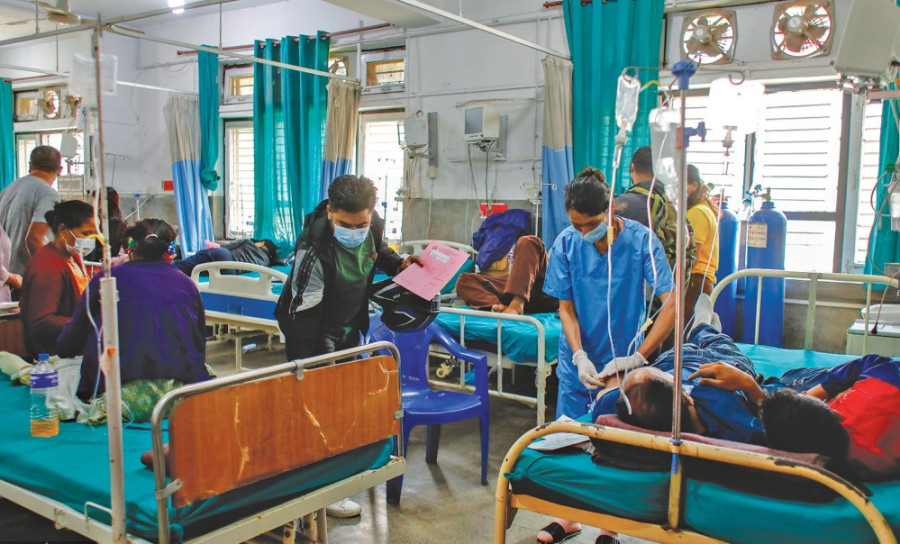Columns
Know your viruses
The dengue virus is one of the main causes of the break-bone fever outbreak in Dharan.
Dr Sher Bahadur Pun
A few days ago, a 60-year-old female from Dharan visited Shukraraj Tropical and Infectious Disease Hospital in Kathmandu after getting dengue, also known as break-bone fever. According to her, break-bone fever is widespread in the community and is spreading at an explosive rate. Hundreds of patients are unable to get proper treatment due to limited hospital beds. Almost every member of the family is suffering from break-bone fever in Dharan.
Last year, a similar outbreak occurred in Kathmandu, and the majority of patients complained of fever with severe body pain or break-bone like severe pain. Not only dengue but also non-dengue arboviruses (mosquito-borne viruses) circulated during the 2022 Kathmandu outbreak. Arboviruses such as Chikungunya and Zika can also cause break-bone fever in patients. Here, I refer to the Dharan dengue outbreak as the break-bone fever outbreak. The Aedes mosquito, responsible for transmitting the dengue virus, can also transmit the Chikungunya and Zika viruses. Thus, the possibility of co-circulation of these two viruses (Chikungunya and Zika) in the Dharan outbreak cannot be ruled out without laboratory tests.
Main causes
The Dengue virus is considered to be one of the main causes of break-bone fever, and is currently being diagnosed in patients with fever in Dharan. Dengue was first described in 2004 in Nepal. Since then, dengue outbreaks have been observed here at two to three intervals. Nepal witnessed the biggest outbreak of the dengue virus in 2022, infecting at least 53,951 people and causing 62 deaths. High-grade fever, chills and sweating, severe headache, pain behind the eyes, feeling like the eyeballs are dropping, severe lower back and calf muscle pain, trouble falling asleep and loose motion are the main symptoms observed in patients during the 2022 dengue outbreak in Kathmandu.
Doctors have noticed a significantly larger number of patients with hemorrhagic symptoms, such as sudden gum and nose bleeding, reddish discolouration of urine, black stool, heavy menstrual bleeding and unexpected vaginal bleeding, compared to the 2019 dengue outbreak. It shows that dengue is becoming a more severe and complicated disease. I saw dozens of patients who had collapsed every day at the hospital during the 2022 outbreak. One possible reason for observing severe dengue might be due to a change in the serotype. A patient who was infected previously and then again with a new serotype of the dengue virus can develop severe dengue, also known as secondary dengue infection.
In fact, several studies have shown that the serotype shifted from dengue-2 (DENV-2) in 2019 to dengue-1 (DENV-1) in 2022. A large dengue outbreak was also observed in Dharan in 2019, and the possibility of a change in the serotype is highly possible, meaning thousands of people might develop severe dengue and complications. However, at the time of writing, the serotype circulating in Dharan was unknown.
A fever clinic (dengue clinic) has been established in Dharan to screen the dengue virus and treat patients accordingly. Besides the dengue virus, no other arboviruses are included in routine laboratory testing. Nevertheless, non-dengue arboviruses are highly likely to be co-circulating in Dharan. For the first time, a significant number of patients with dengue-like illnesses (dengue test negative) were observed in 2017 in patients from Lalbandi, Sarlahi district. Similar observations were also observed during the 2022 dengue outbreak in Kathmandu. India and Pakistan have also increasingly reported dengue-like illnesses in recent years.
The Chikungunya virus is one of the other causes of break-bone fever which is transmitted by the bite of an infected Aedes mosquito that is also involved in transmitting dengue. Fever, severe joint and muscle pain, headache, nausea, fatigue and rash are the main symptoms of the Chikungunya virus. The symptoms usually get resolved without treatment within a week. However, a growing number of studies in recent years have described neurological complications in patients with the Chikungunya virus. For example, a study published in the Neurology India journal in 2009 found 16.3 percent (49/300) of the cases had various types of neurological complications in patients with the Chikungunya virus. It is worth mentioning here that several patients had complaints of neurological problems (personal communication with the patients’ relatives) during the 2022 outbreak in Kathmandu. Thus, similar experiences may be observed in the Dharan outbreak in the coming days.
Greater surveillance
The Zika virus, though officially not yet confirmed in Nepal, may also be involved in the current break-bone fever outbreak in Dharan. The Zika virus was first reported in the southern neighbour India in 2017. Researchers believe that the Zika virus might be silently spreading across India. In fact, Zika was reported in Uttar Pradesh, which shares an open border with Nepal, in 2021, meaning its entry into the country seems inevitable. The main symptoms of Zika are fever, rash, joint and muscle pain and red eyes.
To sum up, Dharan in the eastern part of Nepal is now become the hotspot of break-bone fever, and it may continue to spread for several more days, weeks or months. The dengue virus has been confirmed to be one of the main causes of the 2023 Dharan break-bone fever outbreak. The Chikungunya and Zika viruses share symptoms similar to the dengue virus such as fever with severe joint and muscle pain or break-bone fever, and therefore, cannot be underestimated, as was done in Kathmandu in 2022 and elsewhere in the past. Moreover, these three viruses are spread to humans through the bite of the Aedes mosquito. Thus, co-circulation of these viruses is not impossible, which underscores the need to strengthen the surveillance system, at least until the break-bone fever outbreak is declared over.




 24.12°C Kathmandu
24.12°C Kathmandu
.jpg&w=200&height=120)














